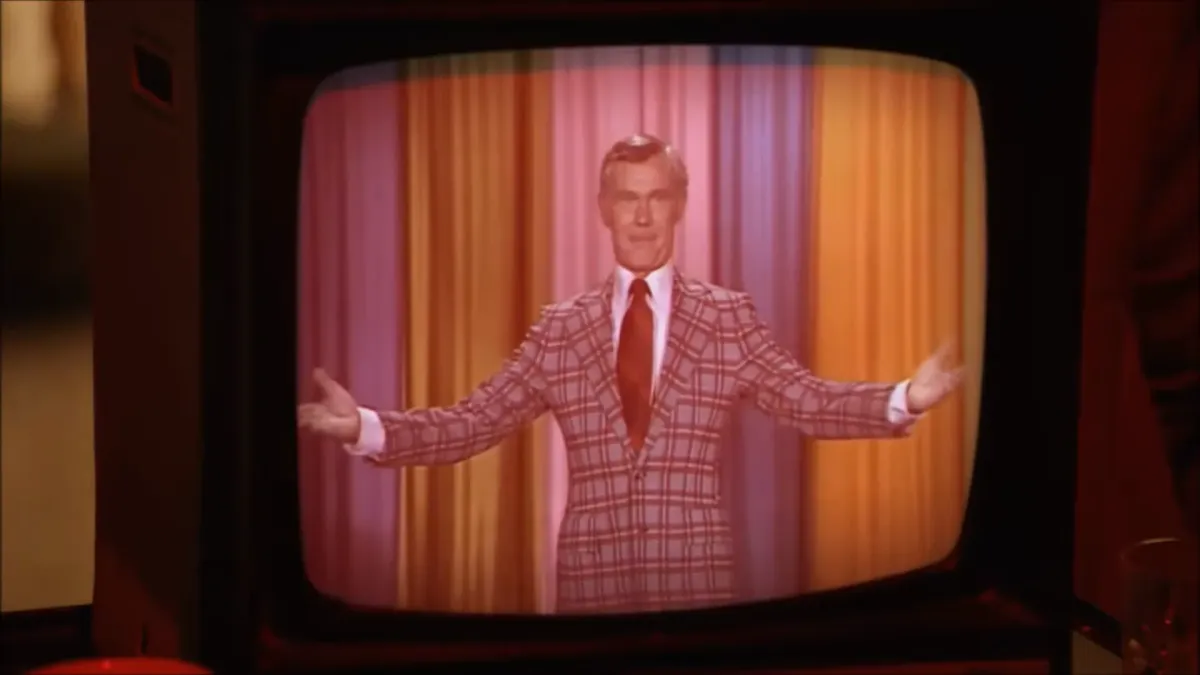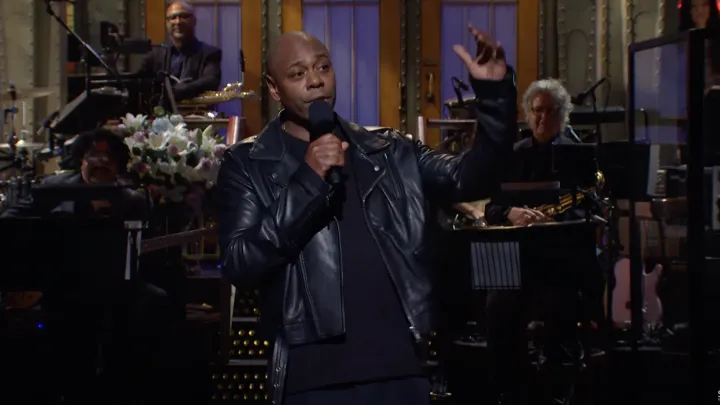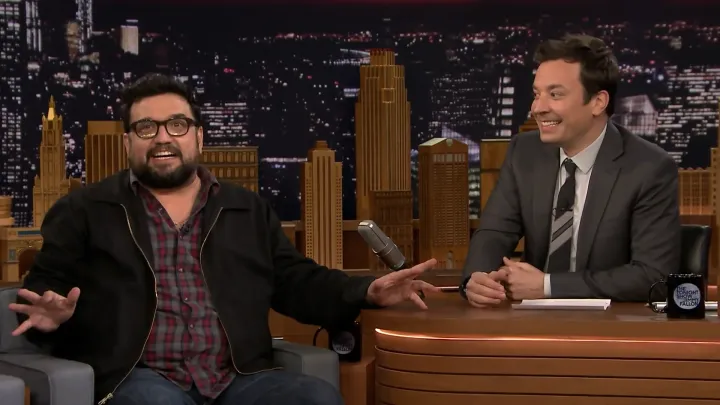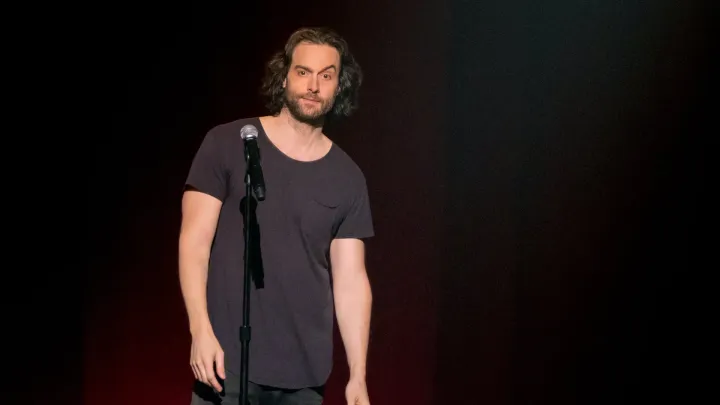"It's crazy how things work out."
Reflections on a dead platform.

The most unfunny funny thing I’ve ever seen was a show called There’s… Johnny!, whose stylization I will disregard for the rest of this column. Co-created and written by Mad About You star Paul Reiser, There’s Johnny was ordered by and set to air on Seeso, the NBC streaming platform that folded unceremoniously before it could show the world There’s Johnny, which was subsequently bought by Hulu and released a week after Louis CK’s cancellation. Please know that everything I’m about to describe is played 100% earnestly.
There’s Johnny follows a 19-year-old named Andy Klavin who watches The Tonight Show Starring Johnny Carson every night with his parents in their quiet town of Valentine, Nebraska. One day in 1972 he writes the show asking for an autograph to give his parents and maybe even a job for himself. When the autograph comes, it’s accompanied by a form letter Andy misinterprets as a job offer. He takes a bus to Los Angeles and a cab to the studio, where he’s surprised to learn the show doesn’t actually shoot at 11:30pm and falls asleep on Carson’s set. The next morning Carson’s secretary, Roz, informs Andy the two-sentence letter he got was the same two-sentence letter everyone gets, to which he responds with one of the many nonverbal reactions that come to define his character: looks of crestfallen dismay, starstruck glee, wide-eyed puppy-like confusion, a vast (but not that vast) repertoire of non-dialogue that might initially befuddle the viewer—why isn’t the protagonist saying anything about all the stuff that’s happening?—but makes perfect sense once you realize Andy is less a TV character than a video game character, an avatar for players assumed to share his fantasy of going behind the scenes of a television show and hitting the “interact” button at various people and objects.
There’s Johnny has been described as Reiser’s “love letter” to The Tonight Show. If this is love, give me heartbreak. Instead of casting an actor to play Carson, There’s Johnny uses archival footage of The Tonight Show to present the host as we already know him, which as also as Andy knows him—a TV personality, a myth. Recycled fiction is all the reality There’s Johnny thinks we need. It’s good enough for the Klavins, after all, whose older son is already serving in Vietnam when they send their youngest off to Hollywood, where he has no family or friends or place to stay, to work for a guy who apparently hired him without so much as an interview. This all happens over about two minutes of montage and voiceover, one of those expositional sequences that tries to launder the creators’ priors into the audience’s. They’re Nebraskans; he’s Johnny Carson. Any poor fool would want to be near him, even a poor fool with no articulated show business aspirations.
After revealing there’s no job for Andy, Roz entrusts him to Joy, the show’s 24-year-old talent booker in the midst of a breakup—not to mention her sick mother and philandering father—who begs to take the boy under her wing (“Can I keep him?”). He meets the writers (all white men who call Joy “Joy of Sex,” a reference Andy needs explained because he’s an uncultured farm lad), punches up a joke, gets punched out by Joy’s ex while retrieving a bag from her car (he’s fascinated by her copy of Kate Millet’s Sexual Politics, and also her bra), and takes a nap on the couch to recover. He wakes up as the show’s about to start taping, drops his jaw at the sight of Carson walking onstage, and finds Joy crying in a green room after an argument with her cheat of a father (a Hollywood big shot who got her the job). She cries into his shoulder, then starts kissing him, then climbs on top of him—her rotten ex told Andy this would happen—and finally pulls herself off, telling Andy he mustn’t speak of this to anyone. Pure, innocent Andy, his face awash with pleasure, promises not to. Then he wanders backstage again, where Roz announces she found a job for him after all.
That’s it, that’s the pilot. You can watch it on Peacock if you don’t believe me. After a Tribeca Film Festival screening in April 2017, the stars and creative team came onstage to enthuse about what a special show it was, how strong and powerful a character Joy is, why Johnny Carson was such an important part of American culture. I almost miss industry events like that, where people who made a pile of dogshit serve you a heaping portion and tell you it’s delicious. No, it wasn’t. There’s Johnny is the apotheosis of a genre for which my distaste is well documented, something I like to think of as auto-fan-fiction—Hollywood stories about how amazing it is to work in Hollywood. What’s remarkable about this one is that it’s so mind-numbingly superficial it circles right back around to telling a true story: the business has always been this easy for a certain type of person. All Andy has to do to get the job is show up and bumble around. All he has to do to get the girl is perform basic niceties. The female lead becomes an object of male fantasy from the get-go, even as the show nods toward the sexism of Carson’s writing staff. Everyone at The Tonight Show, save for a writer (played by our friend Andrew Schulz) who witnesses him making out with Joy, immediately takes a liking to Andy. He has no interesting dialogue and no interiority to speak of, save for an opening voiceover where he marvels that “It’s crazy how some things work out.” Indeed!
You may remember Seeso as the streaming platform that for a brief period gave money to all your favorite up-and-coming Groundlings and UCB comics. Its shows were generally heavy on the improv and light on budget. Some were pretty solid (Bajillion Dollar Propertie$, Hidden America), while others were embarrassingly awful (Take My Wife, whose first season's central conflict revolved around one character's relationship-straining reluctance to quit their job and pursue comedy full time), and they were all united by looking and feeling… kind of cheap. Weird editing choices clearly compensating for something, uneven lighting, clumsy ADR, wooden acting (again, with exceptions), rote direction—the Seeso house style was “We did what we could.” I attended at least one premiere where CEO Evan Shapiro quipped about how little he paid his talent to an audience of his talent. At the time I thought it was odd for an NBC apparatchik to brag about skimping on the show he’d gathered us all to watch, but this was before I learned to think too hard about what Hollywood pays people, which coincidentally only happened after I left New York and stopped going to industry parties. And, look, I liked the parties, they were fun. Open bars, hors d’oeuvres floating around. I do occasionally imagine what my life would be like had I gone down that road, the parties and publicists and puff pieces and parties again, but I chose this life because I wouldn’t last in that one. You’re always meeting some new person whose job is to be interested in you, and to make matters even more confusing, they like their job. Or do they? Maybe some can peel away those layers and keep their appetite for canapés; I cannot. Anyway, Seeso.
NBC announced it was winding down Seeso in August 2017, 19 months after it launched the damn thing. This feels like ancient history now, but there was a good spell in the 2010s where it seemed like the New Digital Platforms of the world, not only Seeso but Super Deluxe and Funny or Die and Seriously.tv and Go90, might actually open up a middle-class life for comedians adrift in an industry averse to spending money on unknown quantities. Of course it was this very aversion that doomed the bubble to pop. When Seeso went down the drain, commentators chalked it up to the unwillingness of media conglomerates to invest in disruption, a buzzword best understood as “stuff that won’t pay off next quarter.” I’m sure this was a true enough assessment of NBC’s logic, but looking back I struggle to see what was disruptive about a video-on-demand platform designed to make lower-quality content than its parent company. I guess that’s comedy for you: if we’re not rooting for a shell game, we’re mourning its loss.
Evan Shapiro, for his part, would go on to become president of the revived National Lampoon, which would go on to sue him for allegedly stealing its money and intellectual property. In early March 2020, a week or so before everything shut down, I ran into a former Seeso employee after a comedy show. They told me that one factor contributing to Seeso’s demise was the exorbitant sum it spent on There's Johnny, apparently against the wishes of some staff. I admit I was satisfied to hear this, even though, if true, it would confirm that Seeso was as much a ploy to make the rich richer as anything else in Hollywood. The Buddha teaches us that life is suffering, and Tom Waits teaches us that bad art destroys the quality of our suffering. I think it’s worth celebrating the rare karmic judgment against people cheapening our brief tenure in hell.
Or it would be without the inevitable collateral damage, all the jobs lost and projects orphaned while executives glide off to the next six-figure paycheck. What's stuck with me about There’s Johnny, a show I watched at a film festival four years ago, is how brazenly it expects me to be nostalgic for an obvious fantasy. Everything’s too easy, too rosy, the world too assured of its own goodness. I can’t stand liars; I’m glad when they fail. I only wish this business didn’t run on their success.
Header image via YouTube.


